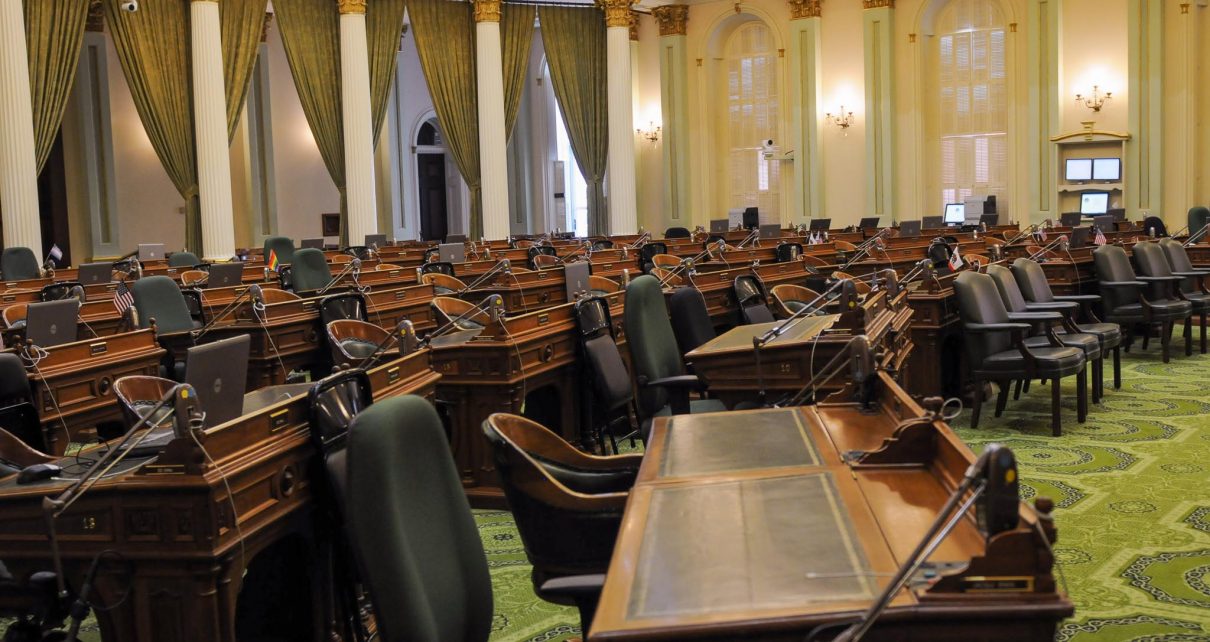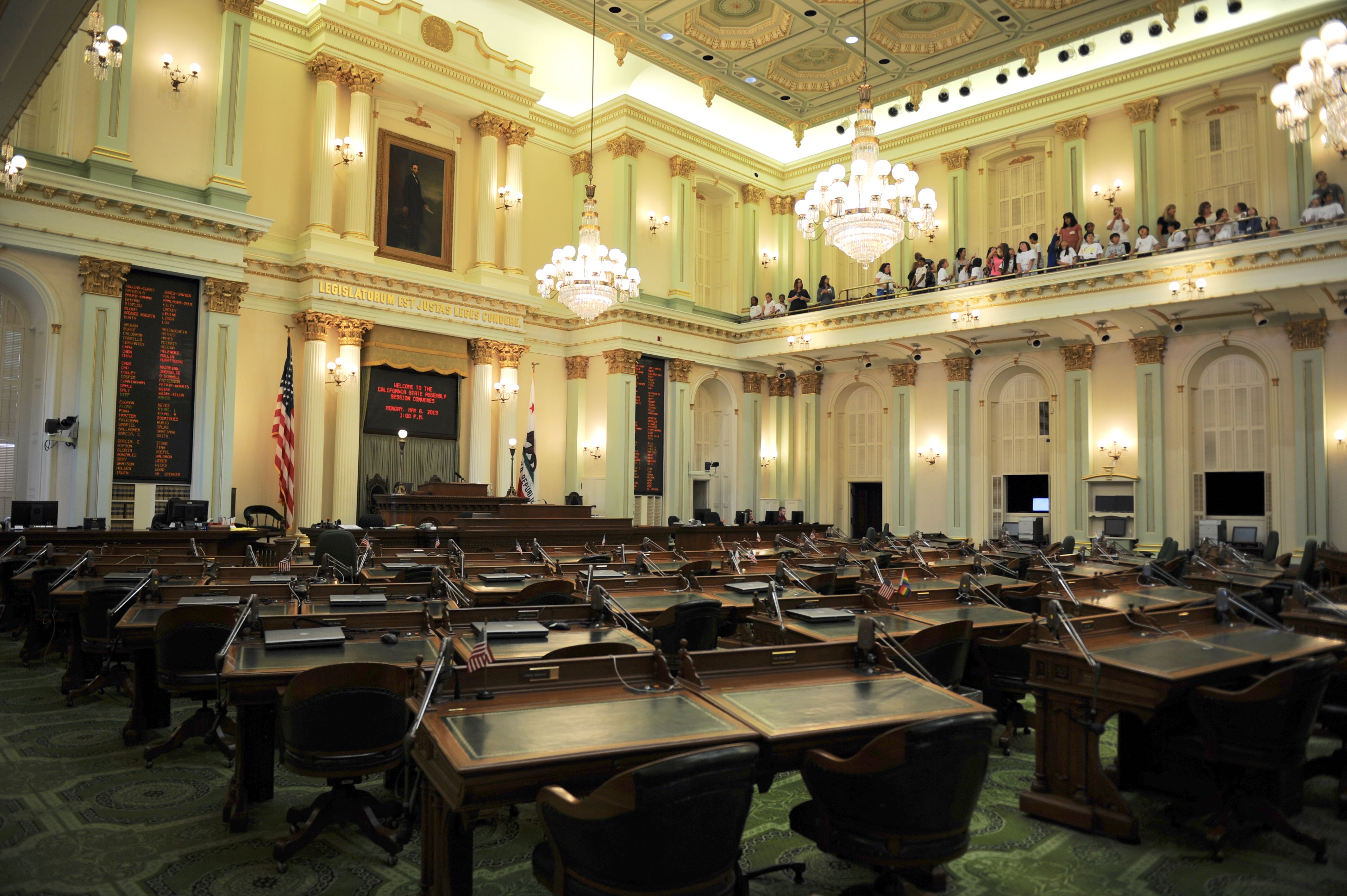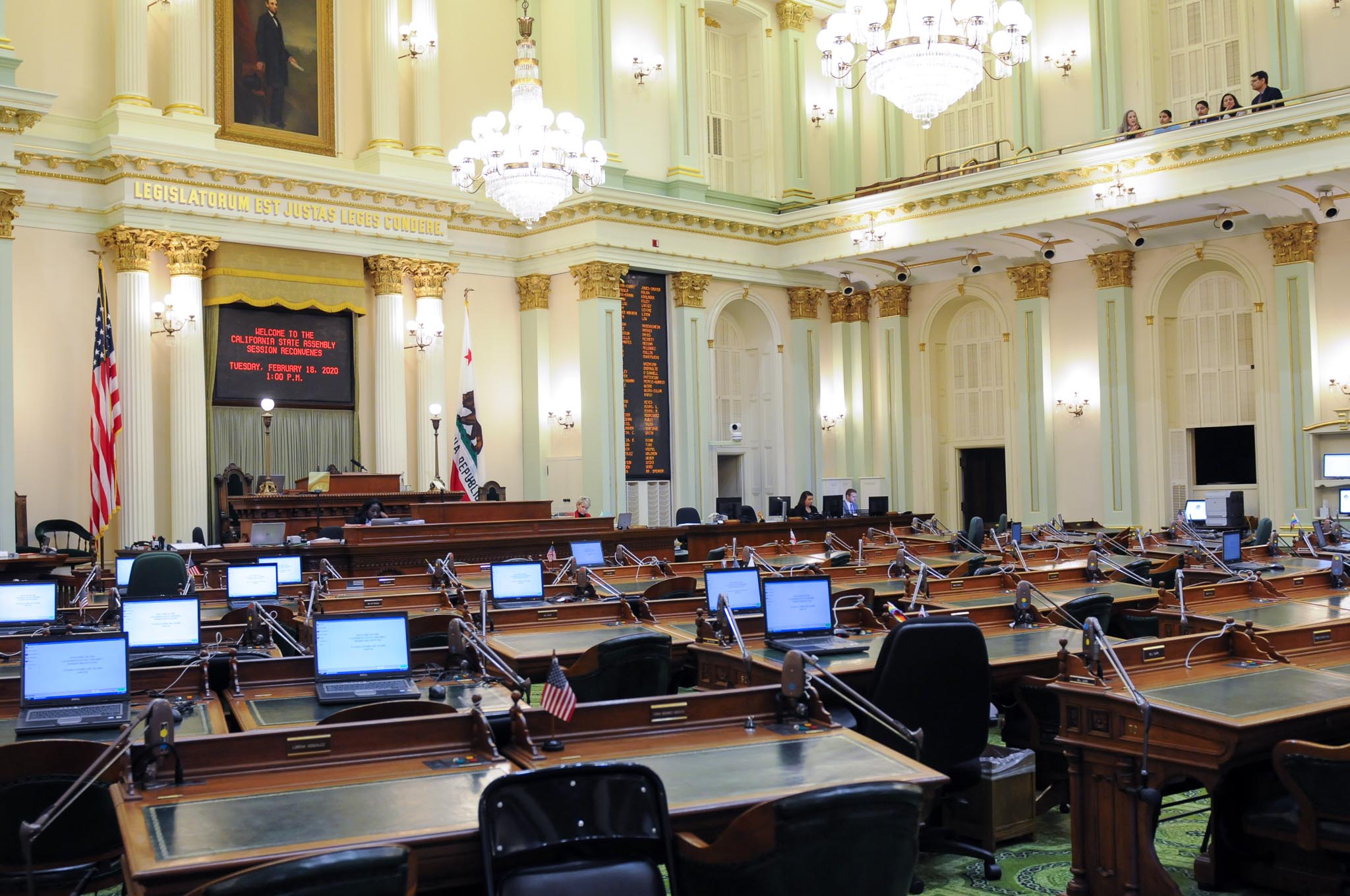
California State Assembly. (Photo: Kevin Sanders for California Globe)
Key Provisions of the Legislature’s Internal Rules – The Assembly Rules – Part II
The reading of the Journal of the previous day may be dispensed with by a majority of Members
By Chris Micheli, April 1, 2020 6:03 am
This is Part ll of Key Provisions of the Legislature’s Internal Rules – The Assembly Rules. Part l is here.
The Sergeant at Arms has specified duties, powers and responsibilities, such as preserving order, announcing messages, supervising assistant Sergeants, and executing all commands of the Speaker. (Rule 33)
In the event of any office vacancy (except Speaker) during a joint recess, the Rules Committee shall fill the office until the session reconvenes. (Rule 34)
The State Printer may not charge any printing or work to the Assembly except upon a written order from the Chief Clerk or the CAO of the Assembly. (Rule 35)
The Chief Clerk is authorized to order the printing of all measures and related documents. (Rule 36)
During session, the Chief Clerk has printed and provided to all Members a complete history showing all actions taken. Clerk also compiles a legislative manual or handbook. (Rule 37)
Whenever the Chief Clerk is directed to transmit copies of resolutions, he or she may do so in specified manners. (Rule 37.5)
The order of business of the Assembly is specified. The Speaker may modify the order. (Rule 40)
At each session, following the prayer, the Members, officers and employees shall pledge their allegiance to the US flag. Guests are invited to join in the pledge by the Speaker. (Rule 41)
The reading of the Journal of the previous day may be dispensed with by a majority of Members. All journals are corrected by the Minute Clerk. (Rule 42)
Whenever documents are presented by a Member, a brief statement of the contents may be verbally made by the author. (Rule 43)
Messages from the Governor shall be delivered to the Chief Clerk and read and printed in the Journal, unless ordered otherwise by at least 54 Members. (Rule 44)
Messages from the Senate are delivered to the Chief Clerk and read and printed in the Journal. The Rules Committee may refer all bills to committee unless 41 Members refer a bill to some other committee. A motion to refer a bill is not debatable. A bill amended in the Senate is placed on the Unfinished Business file. (Rule 45)
These rules do not prohibit the Speaker from permitting the introduction of a special guest. A request that a session adjourn in memory of a person must be made in writing. The request is read by the presiding officer prior to adjournment. (Rule 45.5)
The word “bill” includes a constitutional amendment, concurrent resolution, and joint resolution. Some resolutions are exempt from general rules applying to bills. Resolutions are not “bills” for purposes of Prop. 54’s requirement for 72 hours in print. The 72 hours in print rule applies to Assembly bills when presented on the Senate Floor for a vote upon final passage, and for a Senate bill presented on the Assembly Floor for a vote on final passage. (Rule 46)
Each bill must be signed by each Member who is an author or coauthor before it is introduced. The Chief Clerk assigns a bill a number, reads it the first time, has it printed, and referred to a standing committee, and a copy is placed on all Members’ desks before final passage. The Budget Committee may introduce any number of germane bills. Any other standing committees may introduce a total of five bills each year of the session that are germane to their committee’s jurisdiction. The committee bill must have a majority of committee members’ signatures, including the chair. (Rule 47)
Whenever the author of a bill is no longer a Member of the Legislature, upon request of a committee or current Member, the Rules Committee may authorize the committee or Member to be the author of the bill. (Rule 47.1)
A Member may introduce no more than 50 bills in the regular session, unless the Rules Committee suspends this rule. (Rule 49)
The Rules Committee may refer each bill to a committee by a majority vote, unless a majority vote of the full Assembly refers the bill to another committee. Rules Committee may re-refer a bill to another committee that shares jurisdiction of the subject matter of the bill. (Rule 51)
A bill that, upon introduction, makes no substantive change in or addition to existing law, except a bill stating legislative intent to make necessary statutory changes to implement the budget bill, may not be referred to a committee. Amendments to spot bills may be referred to committee as author’s amendments, but no vote may occur until the bill is in print for at least 15 days. (Rule 51.5)
After introduction and first reading, all bills are delivered to the State Printer. (Rule 52)
All resolutions are numbered and may be referred to the appropriate committee by the Rules Committee. Each resolution must be signed by the author and coauthors. (Rule 53)
A concurrent resolution or a house resolution may be introduced relating to a present or former elected official or a member of the immediate family. Other resolutions are prepared as Rules Committee resolutions and are presented to the committee for action. (Rule 54)
Subject to the Joint Rules, the Assembly Rules govern the conduct of all committee hearings. (Rule 55)
All standing committees meet at the hour and place provided by the Speaker, unless permission to change is granted by the Speaker. When an unscheduled meeting of a standing committee is ordered, it must convene in a readily accessible place for the public and the public should be informed of the hearing being called. No such meetings can occur in the Assembly Chamber. Committees may adopt procedures to hear bills of similar subject matter groupings. (Rule 56)
All bills referred to a standing committee must be set and heard if requested by the author. If author’s amendments make a substantial substantive change to the original bill, the committee shall either hear the bill or re-refer it to the Rules Committee. (Rule 56.1)
Each standing committee must prepare an analysis of every bill it has set for hearing and make the analysis available to the public at least one working day prior to the hearing date. For the Budget Committee and Appropriations Committee, the analysis must be available to the public at the beginning of the hearing. All analyses are provided to the Assembly Floor Analysis Unit. (Rule 56.5)
The committee consultants are responsible for monitoring bills assigned to their respective committee throughout the entire legislative process. Except for resolutions and bills on consent calendar, a consultant must prepare in a timely fashion an analysis of every bill on third reading or on the unfinished business file, as well as any amendment to a bill on third reading. The Floor Analysis Unit is responsible for the final editing. (Rule 56.6)
If the committee chair proposes to recommend any bills for consent calendar, without hearing testimony on the bills, a list of those bills must be made available to the public at the same time as the committee analysis is released. (Rule 56.7)
A majority of a standing committee constitutes a quorum for the transaction of its business, including recommendations to adopt any amendments. Any vacancy shall not reduce the votes required to take action on a bill in that committee. A Member shall advise the committee chair of any disqualification for that Member and the chair shall announce that at the beginning at the hearing. (Rule 57)
After a committee has voted on a bill, reconsideration may only be granted once. Reconsideration may be granted within 15 legislative days or prior to interim recess, whichever occurs first. A majority vote of the committee is required. (Rule 57.1)
All committees must act upon bills referred to them as soon as practicable. The chair must report bills back to the Floor in the same order as they were acted upon by the committee. (Rule 58)
The Appropriations Committee may maintain a suspense file to which bills are referred by majority vote of the committee members who are present and voting. A bill can be taken off suspense file and heard with two days’ notice and a majority vote of those present and voting. Any amendments while on suspense will return the bill to suspense file as amended. No other committee may have a suspense file. (Rule 58.2)
When a committee takes action on a bill, the vote may be by rollcall vote only. All rollcall votes are recorded by the secretary on forms provided by the Chief Clerk. The vote record must be transmitted to requisite places. The bill author can request the roll remain open until the committee meeting adjourns. A bill cannot pass out without a quorum being present, but this rule does not apply in specified instances. (Rule 58.5)
Whenever a bill fails in committee, but the subject matter of the bill is referred for study, the standing committee retains the bill in its possession and reports its recommendation to the Assembly. (Rule 59)
A committee chair may not preside at a committee hearing to consider a bill of which he or she is the sole or lead author, except the Budget Committee Chair may preside at the Budget Bill hearing. (Rule 60)
Specially prepared reports of committees are delivered to the Chief Clerk and are read and printed in the Journal, unless the Speaker orders otherwise. For reports by joint committees, the Speaker must refer the report to the standing committee for review and action. (Rule 61)
- Jurisdiction in Certain Civil Actions - May 29, 2025
- California Recreational Boating Trails - May 28, 2025
- Default by Lessors - May 27, 2025







